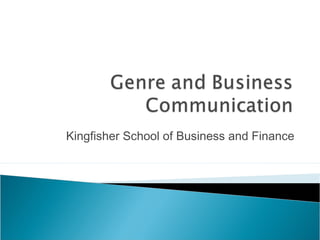
04
- 1. Kingfisher School of Business and Finance
- 2. “The word genre comes from the French (and originally Latin) word for 'kind' or 'class'. The term is widely used in rhetoric, literary theory, media theory, and more recently linguistics, to refer to a distinctive type of 'text'*.” (Chandler) “Conventional definitions of genres tend to be based on the notion that they constitute particular conventions of content (such as themes or settings) and/or form (including structure and style) which are shared by the texts which are regarded as belonging to them.” (Chandler)
- 3. Genres are groups of texts that have specific features, specific purposes, and inspire (or create) certain types of action. Genres often have particular sets of “rules” or expectations for form, presentation, or content attached to them. It’s difficult to define genre exactly or to be able to rigidly assign texts as “belonging” to a particular genre, although plenty of people have tried.
- 4. Genres can be seen as systems; different genres interact with and influence each other. Sometimes one genre incorporates another, or multiple genres can be seen at work in one text.
- 5. Genres relate to the media in which they are presented. “The interaction between genres and media can be seen as one of the forces which contributes to changing genres. Some genres are more powerful than others: they differ in the status which is attributed to them by those who produce texts within them and by their audiences.” (Chandler)
- 6. One way that we understand genres is by looking at different texts within a genre and comparing and contrasting their features.
- 7. “Every genre positions those who participate in a text of that kind: as interviewer or interviewee, as listener or storyteller, as a reader or a writer, as a person interested in political matters, as someone to be instructed or as someone who instructs; each of these positionings implies different possibilities for response and for action. Each written text provides a 'reading position' for readers, a position constructed by the writer for the 'ideal reader' of the text.” (Kress 107)
- 8. Genres change over time; they are dynamic, adapting to different groups, media, and purposes. Genres can be re-purposed as the needs of people and groups change, or as society changes the way in which it uses information technologies.
- 9. Genres come from and inspire social action and are intertwined with the needs and values of cultures and social groups. Classifying genres can be difficult, but generic analysis can be useful in helping us understand how texts work and what kinds of actions they inspire.
- 10. Carolyn Miller’s 1984 essay on "genre as social action” identifies five specific features of genre common to writing. Genre is: 1.comprised of categories of discourse resulting from social action; 2.rule-governed to some degree; 3.distinguishable from form; 4.constitutive of culture; 5.a mediating force between the individual and society. (36-37)
- 11. Purpose Content/subject matter Textual features and conventions Format and design conventions Medium Audience (real and constructed) and their expectations Cultural and social background
- 12. Identifying textual features Understanding audience needs and expectations Understanding conventions for design and content Knowing appropriate style and tone Having a pre-made structure Expecting actions and change Analyzing and understanding how to make writing effective
- 13. We can classify texts as belong to a genre in different ways: ◦ By subject matter (management books, self-help books) ◦ By type of text (letters, memos, speeches) ◦ By medium (written, oral, mixed communication)
- 14. Business communication texts normally classify genres: ◦ First by medium ◦ Second by type of text ◦ Finally by subject matter.
- 15. Three types of media: ◦ Written (conveyed in writing) ◦ Oral (spoken) ◦ Mixed (contains features of both oral and written communication)
- 16. Letters Email Memos Reports ◦ White Papers ◦ Feasibility Studies ◦ Informational ◦ Persuasive Promotional Materials ◦ Brochures ◦ Advertising copy Web sites Documentation PowerPoint presentations Applications Employment documents
- 17. Phone calls Meetings Speeches Conversations Presentations Audio/video recordings
- 18. Instant Messages Web sites that contain audio and video PowerPoint presentations that contain media clips Performance evaluations (written plus a meeting)
- 19. Locate sample texts Analyze purpose and audience Note similar features (content, presentation, design) Ask questions of the writers Look for sources of advice about this genre (style manuals, advice books) Use documents as models